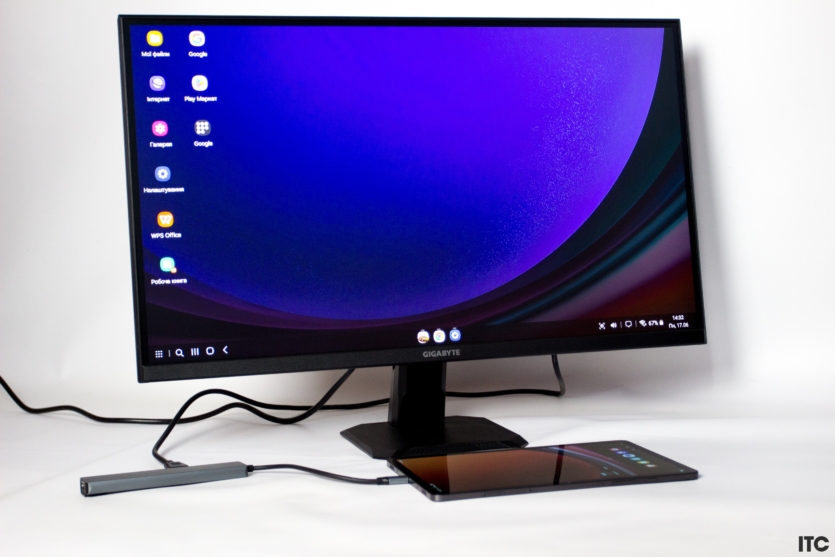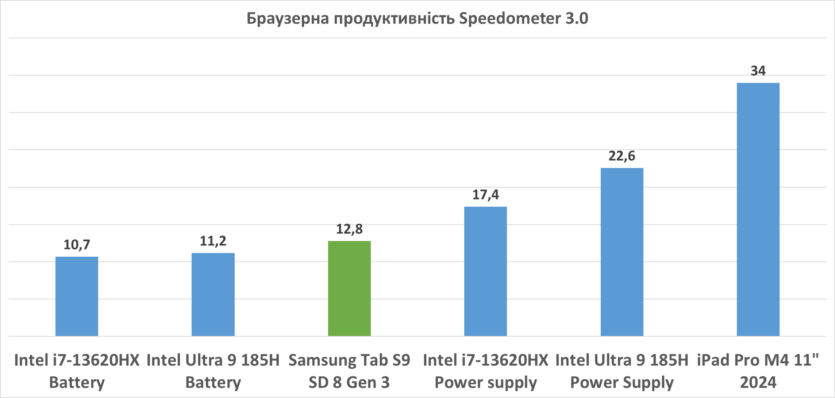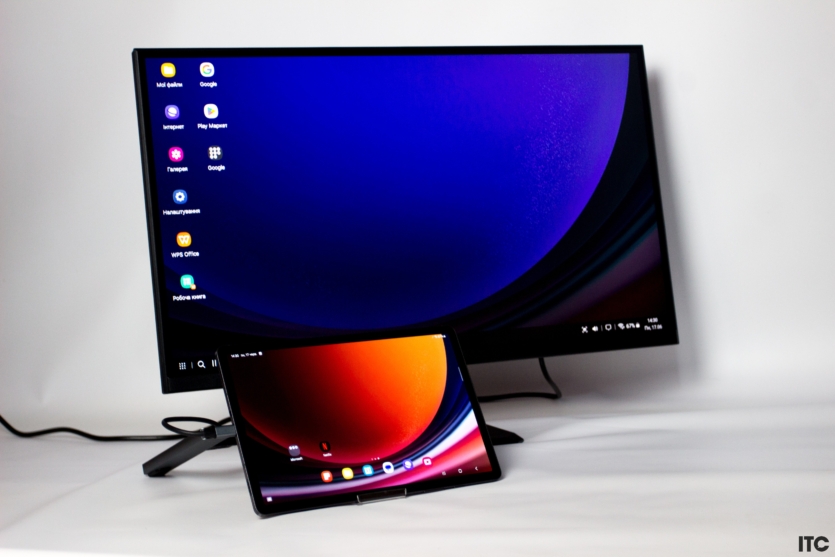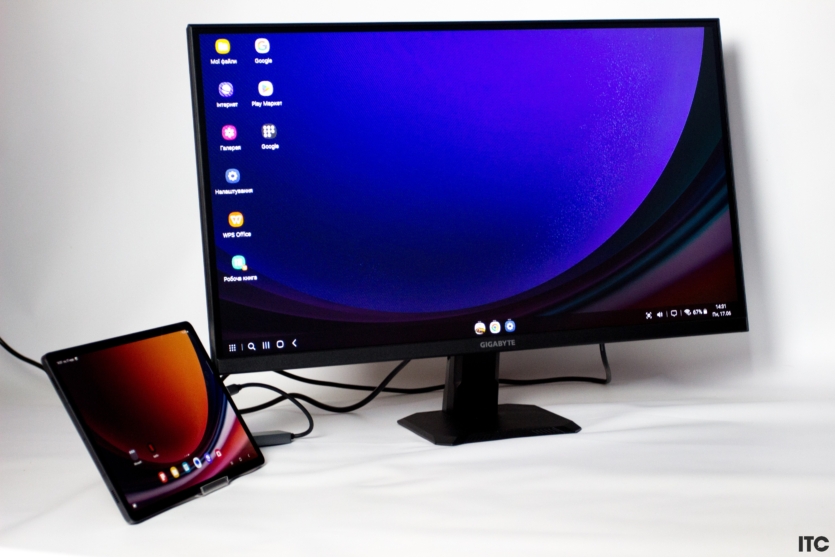Seven years ago, Samsung DeX technology was released, but many people still haven’t heard of it. That’s why we decided to look into its relevance, as it promises to replace a full-fledged computer with just a smartphone or tablet, a docking station, and a monitor.
What is Samsung DeX?
Samsung has developed a special mode for Galaxy smartphones and tablets. When the device is connected to a monitor, it changes the Android operating system interface to a familiar look for computer users.
The first device to support DeX was the Samsung Galaxy S8 smartphone. As time went on, developers did not forget DeX, but rather developed it by adding new features. Since then, the technology has changed and received several improvements, including the ability to connect wirelessly or work with a computer.
On large tablets, this mode can be used directly on the device itself. On the 11-inch Samsung Galaxy Tab S9, this is not very convenient, but with the Tab S9 Ultra version and keyboard, it is already becoming a full-fledged replacement for laptops.
In this review, we’ll test the classic mode with a cable connection with a tablet, to a station, monitor, keyboard, and mouse. You can learn more about DeX features on the official website.
Test bench
We studied the capabilities of Samsung DeX with such components:
The docking station of an unknown manufacturer has the following connectors in addition to the USB Type C input:
- 1 x USB Type C for charging;
- 1 x USB Type C for data;
- 1 x HDMI;
- 2 x USB Type A;
- 1 x RJ-45;
- 1 x micro SD;
- 1 x SD;
The quality of the product itself is low, and the ergonomics are not well-thought-out. For example, the connectors are placed very close to each other, which often prevents you from connecting USB drives, etc. Samsung recommends using the original DeX station, but you can work in this mode with this hub as well. The main thing is that it outputs a high-quality image without delays.
Interface and working capabilities

Within 30 minutes of working in the Samsung DeX environment, you can forget that this is not a classic desktop with an x86 processor, but a mobile device connected to a monitor. The interface is concise, simple, understandable for beginners, and well adapted.
In the settings, the user can select the sound source, adjust the screen and its borders, control the layout of the physical keyboard or display a virtual keyboard on the tablet display. They can also change the pointer settings, select the screen resolution, and more. There are also options to customize the toolbar and desktop appearance.
In the browser, we get the experience of a regular desktop computer. The Snapdragon 8 Gen 2 tablet is fast, stable, and well-optimized sites open with lightning speed. The performance is about on par with a budget-class laptop or a typical office monoblock.

There is no question of equal competition with powerful computers or flagship laptops, although the Snapdragon 8 Gen 2 core can put a lot of x86 processors of AMD Ryzen and Intel Core of the latest generations on the ground. The thing is that the ARM chip does not lose power without power from the outlet, but the x86 does.
A nice bonus is that the phone can act as a touchpad, keyboard, or both. In the case of an 11-inch tablet, you can use it to type, but for a 7-inch smartphone, you’ll have to buy a physical keyboard because it’s inconvenient to work in this mode.
Samsung DeX can also recognize the manufacturer of peripherals. Not only modern keyboards/mice, but also outdated models are correctly detected. Drives, memory cards, and almost anything else that can be connected via the USB interface are also easily connected. Wired Internet also works perfectly.
It is much easier to understand such a «PC» person without a technical education than the Windows system. For basic home use (browsing, watching videos, multimedia), DeX is excellent, but what about professional programs?
Android has good office programs, photo/video editors, so for a copywriter, journalist, SMM manager, and many other professions, Samsung DeX has enough features. Anything that is not available in the Play Market can be launched in the browser. This is especially important for those who work in various CRM systems, etc.
The windows can be moved in any order, but a maximum of five windows are displayed at a time. That is, the tablet keeps 10 programs running in the background, but shows a limited number of applications in windows on the desktop. This unnecessary artificial limitation is annoying because Tab S9 has 8 GB of RAM, which is more than enough for several dozen applications.
DeX’s functionality and features are far superior to the console Xbox Series S which was also tested as a personal PC. The difference is enormous after the console, which has no multitasking, a slow browser, and no classic desktop with windows. For work, this is a great option, which is not the case with video games.
Gaming features and emulation
It’s not all that simple with games, as most projects are adapted for touch control. Some have gamepad support, but it’s better to forget about the keyboard + mouse combination – only a few detect the keyboard (for example, Asphalt 9). Some games refuse to work in windowed mode, and when you switch to full-screen mode, the game restarts.
Call of Duty Warzone Mobile is worth mentioning for an unpleasant bug. The game does not work with any controls, including touch controls, if you launch it in the classic DeX mode. That is, the tablet/phone display is not duplicated on the monitor. With screen duplication, there is no such problem, but black bars appear around the edges.
Since the monitor has an aspect ratio of 16:9 and the tablet 16:10, Call of Duty Warzone had to be played with stripes. With a smartphone, it will be no better because Samsung’s flagships have 2:1 displays, so there will be stripes in this game, but they will be horizontal.
In theory, the Winlator emulator allows you to run any x86 games. It’s worth praising the developers of this miracle because out of five games, I managed to play only Stronghold Crusader HD. Some games start and freeze, some don’t start at all. In fact, this is a good result, given the adequate system performance and maximum availability of the emulator.
Winlator installs in a minute, and the next minute the container is created. Then all you have to do is download video games or programs. No one guarantees that this or that x86 program/game will work correctly, but the fact of working emulation is confirmed.
Conclusions

Without exaggeration, the Samsung DeX can indeed replace a personal PC, but not for all categories of people. Many professions are heavily dependent on Mac OS, Windows, or Linux environments, so they won’t be satisfied, although most users will definitely be.
The developers have done a good job of providing the simplest, easiest, and most enjoyable user experience in a clear interface, squeezing the most out of the Android operating system. Of course, Samsung DeX has its own software nuances and bugs, but these are trifles compared to its advantages.
Samsung DeX allows you to create a compromise, but extremely economical workplace that can run on a charging station for tens of hours. Of course, this is subject to the use of a low-power IPS monitor (Gigabyte GS27F consumes 10 watts).
The most important thing is that every owner of a Samsung smartphone/tablet starting with the Galaxy S8 can try DeX to see if it is suitable for regular use with minimal financial costs for a docking station. Moreover, nowadays, a frugal computer (which is always 100% synchronized with a smartphone) looks particularly promising.




